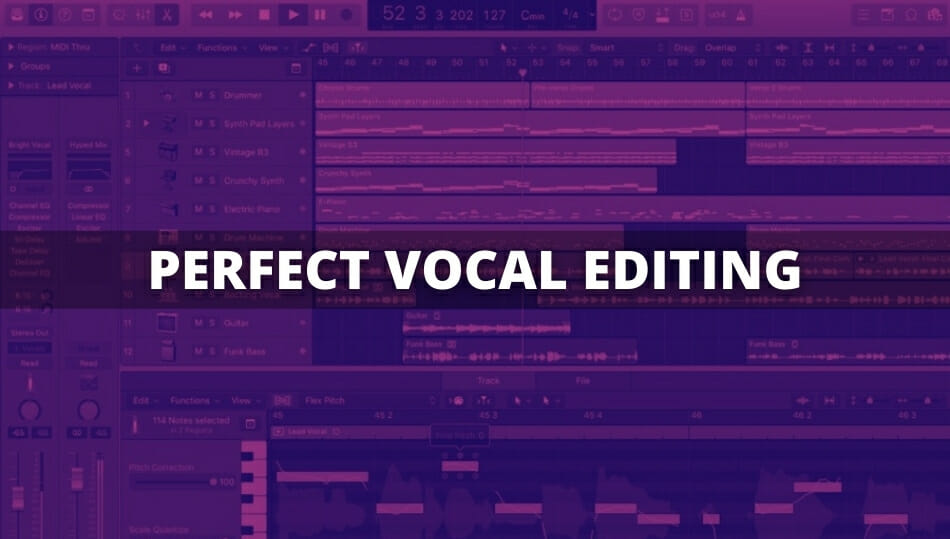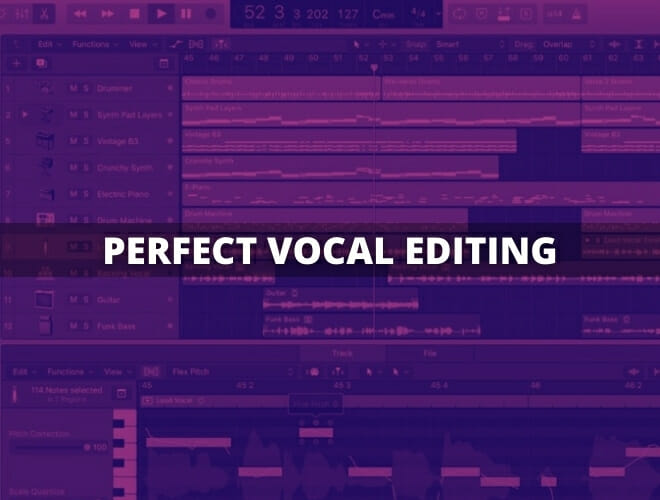7 Steps to Perfect Vocal Editing!

For most mixing engineers, vocal editing is an unpleasant task that is often delegated. However, it is the editing of vocals or raps that separates the wheat from the chaff. This makes it all the more important to know exactly what to look out for.
Find The Intersection
Especially in the main track, poorly cut transitions are immediately noticeable. Therefore, one should not make a mistake here. However, since a song is rarely sung through from front to back, this has to be concealed.
If you do the recording yourself, ask the artist to sing at least two bars of the previously cut take. This usually makes the transition look more natural and fluid. Another reason for this is that you have more leeway for the necessary editing.
Setting the perfect cut is sometimes not so easy. Sometimes a sentence beginning or a word in the middle of a sentence is suitable. In my experience, you can cut the material well at the sound of consonants (K,P,S,T). These are difficult to adjust in pitch. That is exactly why they are suitable, because they usually sound very similar to the same. By the way, the most suitable are decaying S sounds.
On the other hand, I would advise against cutting in vowels (a,e,i,o,u). Exactly with these you form the melody. Thus, the variations are virtually infinite.
Set Fades
After a cut, you should always doctor the material well so that it does not crack. To do this, you can unthread and thread the regions, or you can use a so-called Equal Power Crossfade.
The normal fading out and in of the cut tracks can make sense if you don’t cut the tracks within a word. As soon as you cut within a vowel, this fade technique can cause the material to pump for a short time. Ideally, you should use an equal power fade. This lets both tracks merge, so to speak. The volume does not drop, but remains constant.
If Nothing Happens, It Can Be Removed
The rule is relatively simple and obvious. Unless you’re mixing a live album or an absolute acoustic song, you should cut away everything where nothing is happening. Each track has its own noise level. This could be noise from the recording equipment, the rustling of a vocalist’s chain, the singer clearing his throat, or anything else.
The point is that every sound adds up. Especially when there are a lot of background or chorus elements, little things that you didn’t notice before can suddenly become present. To avoid this, I would cut away everything where nothing is happening.
Alternatively, you could use a gate. However, I would do without it, especially for dynamic recordings. In the worst case, the material is cut off during very quiet vocal passages. You definitely don’t have the same control as with the scissors. That’s why I recommend this tool here.
Customize Breather
Breathers are part of the performance. A song without breathers sounds mechanical and sterile. A loud breather can also be extremely annoying. Therefore, my recommendation is to find a healthy balance. In my opinion you should only cut out breathers in extreme cases. I therefore recommend adjusting the volume of the breathers.
Adjust Particularly Loud or Quiet Passages by Hand
While we’re on the subject of adjusting volumes, let’s get right to it. A compressor is great for making vocals punchier. However, I’m not a fan of compensating extreme volume differences with the compressor. Especially with very dynamic performances at the microphone, I adjust the volumes to each other.
The disadvantage of extreme compressor settings is also that the compressor works extremely. In the worst case, this can lead to the material sounding extremely spiky and distorted. If you adjust the volumes well beforehand, you can ensure a homogeneous compressor performance throughout the entire song. This way, you will not experience any unpleasant surprises.
Do Not Sit too Close to The Wall
The frequencies want to spread out in the room. Unfortunately, this is even more difficult, especially in small rooms. The listening position is ideally ⅓ of the room away from the wall.
If this is not possible, every meter that the boxes are away from the wall counts.
Synchronize The Timing of The Tracks
This point refers to background or double tracks. These should absolutely be in sync. This prevents a washed-out and muddy sound. Duplicate tracks that you can only feel and not hear are best.
Synchronize Pitches of The Tracks
Just as important as timing is pitch. The same applies here. Exceptions are, of course, intentional harmonies. But even these should ideally be tuned to the necessary tone. However, I ask everyone not to quantize the material to 100%, because otherwise you take out the musicality and sound machine-like.
Use Delays for Doubling
Since I am relatively lazy when it comes to editing and like to have extremely synchronous doubles, I use a little trick. I use a sample delay and pan the original track to the left and the track delayed by about 20 ms to the right. This creates the popular doubling effect and you have less work when cutting.




